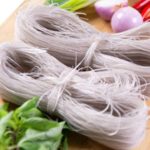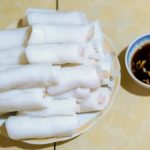Cellophane noodles made from dong rice are a favorite due to their unique chewy texture and flavor, setting them apart from other types of dried noodles made from different kinds of starch. As a popular product, these noodles are often counterfeited, and distinguishing between authentic and fake dong cellophane noodles can be challenging for consumers.
How to Spot the Difference
Have you ever wondered if the dong cellophane noodles you purchased are truly of good quality? If you’re unsure, consider the following tips to differentiate between genuine and fake dong noodles:
Observe the Color
Authentic dong cellophane noodles usually have a natural color, slightly grayish or light green, characteristic of pure dong rice starch. The noodle strands are not uniformly colored, reflecting the traditional handmade production process.
 Dong cellophane noodles can be distinguished by their color (Photo: Dac San Ngon Tay Bac)
Dong cellophane noodles can be distinguished by their color (Photo: Dac San Ngon Tay Bac)
In contrast, fake dong noodles often appear unnaturally bright white or transparent due to the use of bleaching chemicals. Some may even be dyed to make them more appealing. Be cautious if the noodles are overly glossy or have unnatural colors.
Examine the Noodle Strands
When touched, genuine dong cellophane noodles feel dry, slightly brittle, with a subtly rough surface, and non-glossy. On the other hand, fake dong noodles tend to be glossy, sometimes feeling slippery, prone to breaking into crumbs, or displaying inconsistent textures.
Test Transparency by Soaking in Water
Soaking the noodles in water is an effective way to tell the difference. When immersed in cold water, authentic dong cellophane noodles will swell evenly, becoming soft yet retaining their chewiness, without clumping together. Even after a long soak, they maintain their structure and don’t turn mushy.
 How to spot the difference: Soak the noodles in water. (Photo: FPTShop)
How to spot the difference: Soak the noodles in water. (Photo: FPTShop)
Meanwhile, low-quality or fake noodles quickly turn soft and mushy when soaked and may even emit a strange odor. Some may cause the soaking water to turn cloudy, indicating the presence of dyes or chemicals that leach out.
Check the Smell
Genuine dong cellophane noodles typically have a subtle, natural fragrance of dong rice starch, creating a pleasant aroma. If you detect a strong, unusual, or absent characteristic scent, it’s likely that the noodles have been adulterated with chemicals.
Additionally, when cooked, authentic dong noodles maintain their chewiness, with strands that don’t stick together or fall apart, even after prolonged cooking. They offer a mild, pleasant flavor of dong rice, enhancing the dining experience. In contrast, fake noodles may have an odd smell or lack flavor altogether, with a bland taste. During preparation, their structure easily breaks down, causing the strands to clump or disintegrate.
Opt for Products with Clear Origins
In addition to external characteristics, prioritize purchasing dong cellophane noodles from reputable brands that provide clear packaging and origin information. Products from traditional craft villages, such as Cao Bang, Bac Kan, or Hung Yen, tend to offer more reliable quality compared to those sold in floating markets.
Be Wary of Unusually Low Prices
Authentic dong cellophane noodles, especially those handmade by small producers, tend to be priced higher than industrial or fake noodles. If you come across a product with an unusually low price, lacking proper labeling, or sold indiscriminately, exercise caution before making a purchase.
Knowing how to differentiate between genuine and fake dong cellophane noodles ensures not only the health and safety of your family but also guarantees the authentic flavors of traditional dishes. With careful observation, you can easily avoid any confusion when buying these noodles.
According to VTCnews
How to Braise Pork Skin with Pepper: A Delicious and Tender Dish to Enjoy with Rice
Pork Belly Braised in Pepper is a delectable and rustic dish that you must try. This mouth-watering delicacy is a hearty and flavorful treat, and we’re here to uncover the secrets to mastering this culinary delight. Join us as we delve into the art of creating this traditional fare and explore the magic behind its irresistible appeal.






































